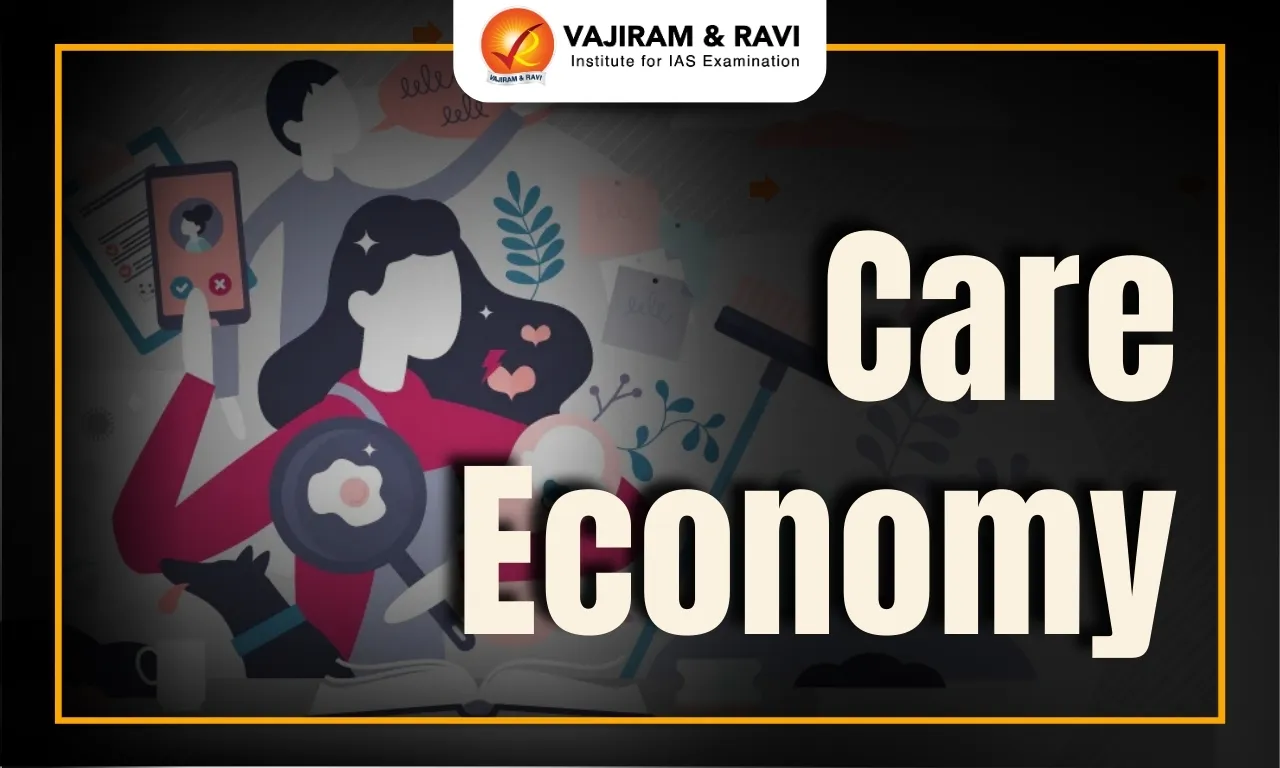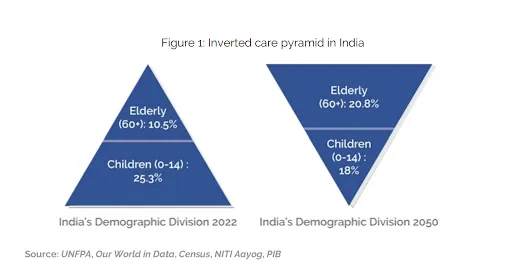Care Economy is the sum of all paid and unpaid activities that provide care and support to people. Care Economy includes care for children, the elderly, and people with disabilities. Care Economy has the potential to generate huge employment in the future. Despite having vast potential, the care work across the countries remains plagued by low wages and non-compensation.
The Care economy is a cornerstone of sustainable development and social well-being. By recognizing its value, investing in its infrastructure, and addressing systemic inequalities, societies can build more resilient and inclusive economies.
Care Economy Definition
The Care Economy, also known as the Purple Economy, encompasses both unpaid and paid caregiving activities. Unpaid work involves nursing or cooking for family members, while paid care work involves domestic workers providing services in exchange for remuneration. Traditionally, caregiving was solely women's responsibility, but it is now shared equally among all family members.
Care Economy Need
Care Economy’s need arises due to the necessity to focus on growth and at the same time cater to the demand of the elderly population. Care Economy also helps support the formal economy and bridges the gender divide. The details are as mentioned below:
- Core of Growth: It helps in sustaining human activity for present and future generations by providing regular care work. According to estimates by the WEF, if unpaid work is compensated, then it would represent 9% of Global GDP.
- Supports Formal Sector Employees: The employees working in the formal sector can sustain their work because their children, older parents, and loved ones are being taken care of by care workers.
- Growing Elderly Population: The Care Economy supports the older population, who are its primary beneficiaries. As their numbers grow steadily, the demand for care services increases.
- According to United Nations Population Fund (UNFPA) estimates, by 2050, 20% of India's population will be aged 60 and above. This demographic shift further expands the need for a robust Care Economy.
- Promoting Gender Equality: The care work traditionally fell on women disproportionately increasing inequality. It limited their participation in paid economic tasks leading to their limited growth.
Care Economy Features
The features of the Care Economy include it being women-centric and most of the workers work without remuneration. The details are explained below:
- Unpaid Work: It forms a crucial part of the Care Economy as most of the work is not paid for as against paid work in a Monetized Economy.
- Role of Women: The majority of work is still done by women in the Care Economy. They spend more time than men in care work.
- Women spend 3.2 times more time than men in care work.
- Human Capital Development: It supports Human Capital Development by taking care of young children, the disabled, etc.
Care Economy and Monetized Economy
Care Economy can be distinguished from a Monetized Economy based on the idea that while a Monetized Economy involves activities that receive direct payments and are included in GDP on the other hand Care Economy includes activities that are either unpaid or paid low-wages. The differences between the Care Economy and the Monetized Economy are discussed in the table below:
|
Feature |
Care Economy |
Monetized Economy |
|
Nature of Work |
Caregiving, emotional labor, domestic tasks |
Market-driven goods and services |
|
Payment |
Often unpaid or low-paid |
Paid and monetized |
|
Recognition in GDP |
Mostly excluded or undervalued |
Fully included |
|
Gender Role |
Predominantly women |
More gender-neutral but still male-dominated in leadership |
|
Impact on Society |
Essential for human development and well-being |
Drives economic growth and wealth creation |
Care Economy in India
Indian economy is undergoing a rapid change with a focus on urbanization and nuclearization increasing rapidly. The disruption in joint family structure and the move towards smaller nuclear families has highlighted the importance of the Care Economy in India. According to the International Labour Organization (ILO), increasing investments in the Care Economy can help India generate 11 million jobs of which nearly 70% will go to women.
Need for Care Economy in India
The need for a care economy in India is due to factors like the changing demographic profile of the country, gender divides, lack of recognition for care workers and to utilize the business potential. The details are explained below:
- Changing Demographic: Elderly population is expected to increase between 2020 to 2050 although the fertility rates are decreasing thereby indicating a need for more care workers.
- Gender Inequality: Most of the unpaid work is being done by women resulting in increased gender divides. According to NSO, women of working age (15-59 years) spend most of their time in unpaid work whereas men of the same age spend time in paid work.
- Double Burden of Work: Working women in India have to face an even higher burden of work due to unpaid care work. But literate men have to spend less work on unpaid care work when compared to non-literate males.
- Support GDP growth: The economic value of women’s unpaid domestic and care work can contribute to 15-17% of GDP if accounted for and will help in improving the economic status.
- Business potential: Increasing investments in the Care Economy can bring a win-win situation as it can boost employment as well as supply caregivers for the needy.
Care Economy Challenges
The Care Economy faces various challenges ranging from the lack of policies to the lack of infrastructure support. The challenges also include gender disparities, labour rights violations, and low government spending. The challenges are discussed in detail below:
- Undervalued Unpaid Work: The unpaid work in the Care Economy is often undervalued leading to lower wages and increased disparities.
- Over-representation of women: The burden of care work has been disproportionately falling on women leading to their mental fatigue and overall loss of well-being.
- Lack of Policies: The absence of clear guidelines and policies for care workers leads to a lack of career advancement for them.
- Inaccessible Labour Rights: Even the paid care workers find it difficult to access their rights and liberties. In India, many paid caregivers like Anganwadi workers, Auxiliary Nurse-Midwives (ANMs), and Accredited Social-Health Activists (ASHAs) are not provided with fixed monthly salaries in several states.
- Low Government Spending: The focus on Care Economy has been less which is highlighted by the fact that Government spending is low in this area.
- In India, Government spending is less than 1% of the GDP on care work infrastructure, and services.
Care Economy Suggestions
The Care Economy needs robust reforms to enhance the overall contribution to economic growth. The suggestions for improvement include creating a policy and identification mechanism for caregivers. Further, there is a need to increase government spending and adopt ILO’s 5R framework. The details are as explained below:
- Policy formation: A suitable policy with proper definition and guidelines for care workers needs to be created. It will allow the workers to get recognition and increase their economic potential by getting more matches with care seekers.
- Identification: The caregivers need to be identified and then brought into the formal system through identification mechanisms like ID Cards, online portals, etc.
- Increase Government Spending: The Government spending on the Care Economy needs to improve to create more infrastructure and services for both paid and unpaid workers.
- Utilize International Frameworks: The ILO provides a 5R framework for decent care work. This framework aims to improve the working conditions for care workers and achieve gender equality.
- Awareness generation: Focus should also be given to creating awareness about the importance of the Care Economy and tackling the patriarchal mindset.
Care Economy Initiatives
The Government and Private bodies across the world and in India have taken various initiatives to support the care economy. This support is crucial in developing the care economy and making it complement and supplement the monetized economy.
Government Initiatives
The Government of India has been proactively working to improve Care Economy in the country. It has brought several initiatives like Saksham Anaganwadi Poshan 2.0, Palna Ghar, Rashtriya Vayoshri Yojana, Child-Care Leave (CCL) Policy, etc. The initiatives taken are discussed in detail below:
- Saksham Anganwadi Poshan 2.0: Saksham Anganwadi and Poshan 2.0 is an Integrated Nutrition Support Programme. It seeks to address the challenges of malnutrition in children, adolescent girls, pregnant women, and lactating mothers through a strategic shift in nutrition content and delivery.
- It works for the creation of a convergent ecosystem to develop and promote practices that nurture health, wellness, and immunity.
- Palna Ghar: Palna Ghar Yojana is a scheme of the Central Government to provide daycare facilities for the children of working mothers. It is also known as the National Creche Scheme. This care is given to children between the ages of 6 months to 6 years.
- Rashtriya Vayoshri Yojana: The senior citizens from BPL families get physical aids and assistive devices free of cost. The objective of this scheme is to provide equipment according to the needs of senior citizens who are disabled due to old age.
- Childcare Leave Policy: It allows 730 days of paid leave for female employees to care for up to two children under 18, over and above maternity leave.
Private Initiatives
Several Global Organizations have also embarked on the journey to improve the Care Economy and in this regard brought projects related to Child Care, Women's support, and the overall development of the care economy. Some of the significant projects include the following:
- Global Tackline Childcare Project: It is a project by the International Finance Corporation to raise awareness of the importance of employer-supported childcare.
- It showed that employer-supported childcare could result in a win-win-win for families, employers, and economies.
- Childcare Work by Kidogo: Kidogo a non-profit in East Africa, uses a social franchising approach to support women childcare microbusiness entrepreneurs, known as “Mamapreneurs”, in starting and growing their businesses.
Care Economy Way Forward
The lacunae in the care economy can be tackled using holistic regulatory oversight along with suitable investment in the care economy. The gap can be bridged with support from both government and private sector. This will result in improving the Care Economy and fostering inclusive growth along with the creation of new opportunities for women. Therefore, revitalizing the care economy is the need of the hour to realize women-led development in Vikshit Bharat by 2047.
Care Economy UPSC PYQs
Q.1 Distinguish between ‘care economy’ and ‘monetized economy’. How can the care economy be brought into the monetized economy through women's empowerment? (UPSC Mains 2023)
Q.2 With reference to the National Rural Health Mission, which of the following are the jobs of ‘ASHA’, a trained community health worker? (UPSC Prelims 2012)
- Accompanying women to the health facility for antenatal care checkups
- Using pregnancy test kits for early detection of pregnancy
- Providing information on nutrition and immunization
- Conducting the delivery of a baby
Select the correct answer using the codes given below:
(a) 1, 2 and 3 only
(b) 2 and 4 only
(c) 1 and 3 only
(d) 1, 2, 3 and 4
Ans. (a)
Q.3 With reference to the ‘Pradhan Mantri Surakshit Matritva Abhiyan’, consider the following statements:
-
This scheme guarantees a minimum package of antenatal care services to women in their second and third trimesters of pregnancy and six months of post-delivery health care services in any government health facility.
-
Under this scheme, private sector healthcare providers of certain specialties can volunteer to provide services at nearby government health facilities.
Which of the statements given above is/are correct?
(a) 1 only
(b) 2 only
(c) Both 1 and 2
(d) Neither 1 and 2
Ans. (b)
Last updated on December, 2025
→ Check out the latest UPSC Syllabus 2026 here.
→ Join Vajiram & Ravi’s Interview Guidance Programme for expert help to crack your final UPSC stage.
→ UPSC Mains Result 2025 is now out.
→ UPSC Notification 2026 is scheduled to be released on January 14, 2026.
→ UPSC Calendar 2026 is released on 15th May, 2025.
→ The UPSC Vacancy 2025 were released 1129, out of which 979 were for UPSC CSE and remaining 150 are for UPSC IFoS.
→ UPSC Prelims 2026 will be conducted on 24th May, 2026 & UPSC Mains 2026 will be conducted on 21st August 2026.
→ The UPSC Selection Process is of 3 stages-Prelims, Mains and Interview.
→ UPSC Result 2024 is released with latest UPSC Marksheet 2024. Check Now!
→ UPSC Prelims Result 2025 is out now for the CSE held on 25 May 2025.
→ UPSC Toppers List 2024 is released now. Shakti Dubey is UPSC AIR 1 2024 Topper.
→ UPSC Prelims Question Paper 2025 and Unofficial Prelims Answer Key 2025 are available now.
→ UPSC Mains Question Paper 2025 is out for Essay, GS 1, 2, 3 & GS 4.
→ UPSC Mains Indian Language Question Paper 2025 is now out.
→ UPSC Mains Optional Question Paper 2025 is now out.
→ Also check Best IAS Coaching in Delhi
Care Economy FAQs
Q1. What is the concept of the care economy?+
Q2. What are the care economy and monetized economy?+
Q3. What are the challenges of the care economy?+
Q4. What is an example of a care economy?+
Q5. What is the size of the care economy in India?+


















